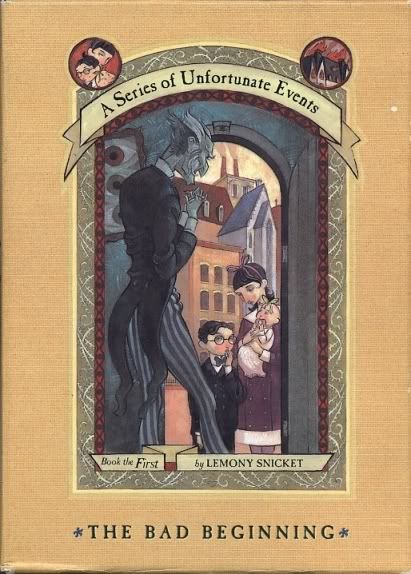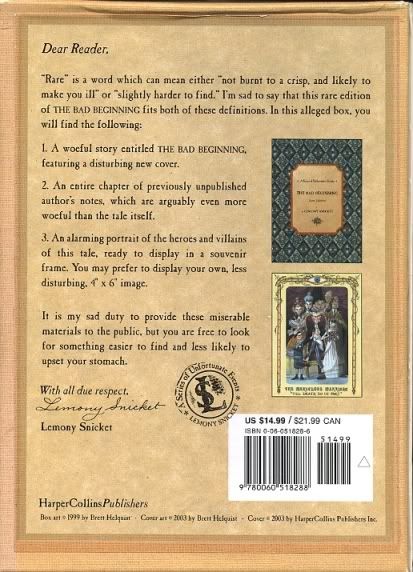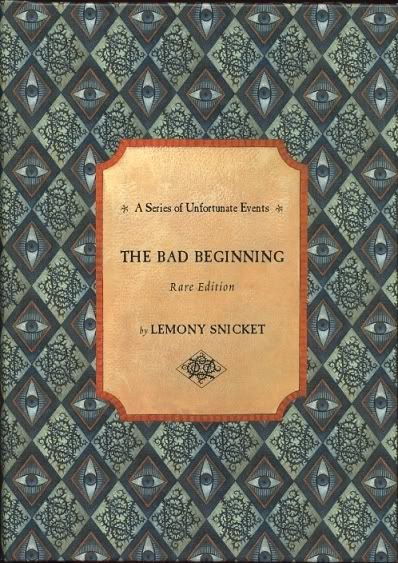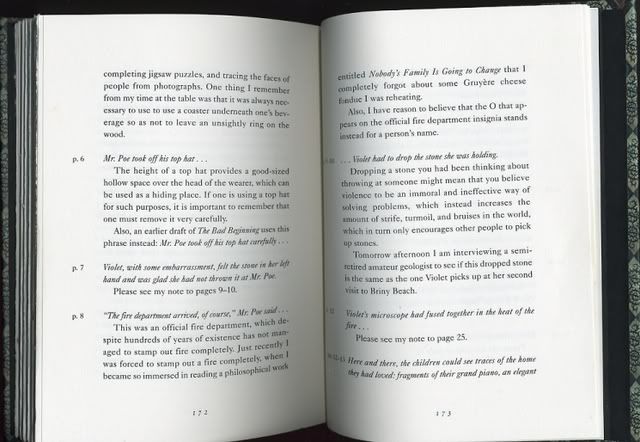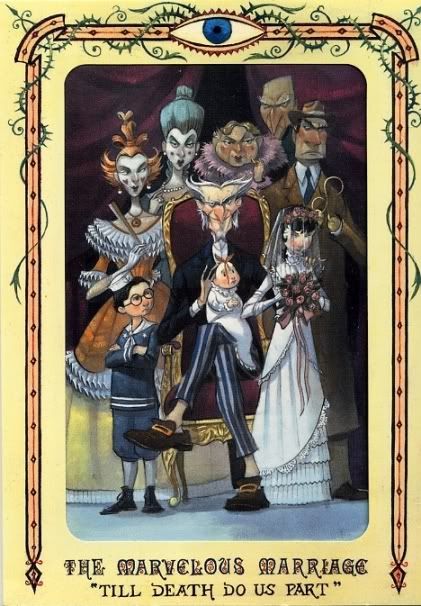One thing this picture brings to mind - and it comes up a few times in the text, as well - is how short Klaus and Violet are. Olaf overtops them even though he is sitting down. Would they really be that short at twelve and (especially) fourteen?
I consider it artistic license. Violet compared to the white-faced women isn't too bad, for example, but Olaf as pictured there must be very tall indeed, and the bald man and the androgynous assistant look very off. So I consider the heights to be a little odd purely as a matter of artistic composition; the quality of the image would suffer without such exaggeration.
Can we accept the images of the henchmen provided as canonical even if we don't accept the image itself to be canonical? Helquist uses a near-identical illustration of the hook-handed man for Chapter Eleven of TGG.
I've no problem with the illustrations themselves; they're how Helquist pictures the characters, and this illustration is consistent with all others. The hook-handed man and bald man are illustrated in later books, while the androgynous one and the white-faced women appear on
The Loathsome Library box set... and while admittedly I haven't seen full scans of that box, what I have seen suggests they're identical. The androgynous one is also illustrated in the
Disappearance! edition of TWW - again, identical. All that's non-canonical about it is that the scene never happens.
The frame is exactly the same size as the BBRE, and fits snugly alongside it in the box. And I think you can indeed take out the Helquist art and put in your own photograph, but you'd have to be mad to do so.
And now, my notes on the
Author's Notes of the BBRE. You should make sure you've read them before you read this:
Snicket’s tale about the origins of the BBRE – that he was besieged with questions about the book, and so on – strikes me as potentially true. As fans, we’ve always had many questions for him, and this may to some degree be what he’s alluding to.
“
On that particular occasion, the Baudelaire parents not only gave their children permission but encouraged them to leave the house, as the adults had some pressing business to attend to. This business was delayed indefinitely due to death.” This suggests that the events the Baudelaires were expecting were superseded by the destruction of the house, i.e. that whatever they wanted to do or were expecting to do, they couldn’t.
“
Also note that the trolley has since collapsed, and its remains were recycled into the foundation of a hotel.” A piece of information that, with the release of TPP, seems likely to have been retconned. Our interpretation prior to TPP was that the Hotel Denouement was a recent construction, which was why the villains didn’t know about it. However, come TPP, there was no indication whatsoever that the hotel was a recent construction. Quite the opposite, in fact.
“
The Baudelaire table was not used exclusively for dinner. Its surface was handy for unrolling maps, completing jigsaw puzzles, and tracing the faces of people from photographs.” This has been raised elsewhere; the Baudelaire children were apparently at this table quite a lot, and yet they had no idea of anything that occurred with respect to V.F.D. Possibly the Baudelaire parents quite often met their comrades for official business while the children were on day trips, or when they were too young to understand what was happening.
“
One thing I remember from my time at the table was that it was always necessary to use a coaster underneath one’s beverage so as to not leave an unsightly ring on the wood.” The idea of beverage holders leaving unsightly rings on wood is referenced throughout TPP.
“
Also, an earlier draft of The Bad Beginning
uses this phrase instead: Mr. Poe took off his top hat carefully…” A plotline which seems to have been dropped. In
The End, we learn that Sadie Bellamy and Olaf are aware of adoption papers hidden under the top hat of a banker called Mr. Poe who had been promoted to Vice President in Charge of Orphan Affairs and who is better known under his stage name. Mr. Poe was not promoted to VPiCoOA until TEE, and at no time has there been any indication that he works on the stage in any capacity. I suggest that Sadie and Olaf are referring to an entirely different Mr. Poe, and that it is for this reason that this line was “redrafted” by Lemony before publication: He learnt that the Mr. Poe with something concealed under his hat was not the Mr. Poe associated with the Baudelaires, and thus the information was not relevant. However, the U.A. does reveal that Mr. Poe and Eleanora Poe are in contact with a mysterious “you-know-who,” and I suggest this would have been linked to the something-under-his-hat plotline. I will go further and hypothesise a connection to the poisonous plant, but more on that later.
“
Also, I have reason to believe that the O that appears on the official fire department insignia stands instead for a person’s name.” Implies that the official fire department, or rather, the Official Fire Department, had an insignia similar to V.F.D., one which combined the letters standing for the name of the organisation. If the O. instead stood for a person’s name, that would suggest that it was, in fact, O.’s Fire Department, a fire department belonging to an individual whose name begins with the letter O. This carries the clear implication that the Official Fire Department has been infiltrated by Olaf – but I have a wide-ranging theory on this that I’ll go into more depth on later.
“
Dropping a stone you had been thinking about throwing at someone might mean that you believe violence to be an immoral and ineffective way of solving problems, which instead increases the amount of strife, turmoil, and bruises in the world, which in turn only encourages other people to pick up stones.
Tomorrow afternoon I am interviewing a semi-retired amateur geologist to see if this dropped stone is the same as the one Violet picks up at her second visit to Briny Beach.”
Foreshadowing an event which occurs in TGG; since the Baudelaire children have apparently visited Briny Beach many times, “second” visit, and indeed the later “third” visit, are taken as referring to visits which happen during the events of the series, with the TBB visit being the first. At any rate, if the rocks are the same, this rock ended up thrown to the bottom of the Hotel Denouement pond. The stone-dropping philosophy is similar to beliefs that I think Handler also shares. Of course, since the stone in question ended up, as I said, in the Hotel Denouement pond, what symbolic interpretation can you make of that?
“
Curiously enough, Mr. Baudelaire’s brandy bottle was found on the remains of the dining table, with no coasters nearby. This would indicate that either the coasters were burned beyond recognition, or the Baudelaires had received a visitor who had no manners whatsoever.” Not the first time that the BBRE will imply that the Baudelaires received a visitor who, let’s face it, was probably Olaf. The BBRE notes would eventually prompt me to speculate that Olaf was the survivor of the Baudelaire fire. If the plotline hadn’t been so abruptly dropped, I feel confident that this information would have been suitably depressing to the Baudelaire children.
“
For more information on respected members of the monetary community, interested parties might turn to my studies of Esmé Squalor, the city’s sixth most important financial advisor.” Suggesting that respected members of the monetary community are not to be trusted, which goes along with the previous dark hint about Mr. Poe’s doings – although, as has been discussed, we can’t really plausibly imagine that Mr. Poe’s a secret villain. My theory was that he was being manipulated by someone he in turn trusted – just like Justice Strauss was being used by the other judges of the High Court.
“
For more information on the destruction of the Royal Gardens, interested parties might turn to the following articles in The Daily Punctilio, the city’s newspaper: “Arson suspected in Destruction of Royal Gardens,” by Jacques Snicket…” Also referenced in TGG. And it was always strange that the Royal Gardens were just a pile of dirt.
“…
and “Absolutely No Arson or Any Other Suspicious Thing Associated with the Royal Gardens, which Simply Burned to the Ground and Then Were Covered in Dirt Due to Wind, Says Official Fire Department,” by Geraldine Julienne.” According to Widdershins in TGG, Jacques “proved” that the Royal Gardens fire was arson; that the Official Fire Department is denying this with a highly implausible explanation suggests they are either as foolish as Geraldine Julienne – or evil. Here’s as good a place as any to put forth my old theory: The Official Fire Department was, by means unknown, corrupted by Count Olaf – or even this Official Fire Department was set up by Olaf – and upon his bidding they burn down buildings. As a fire department, they have every reason to be hanging around burning buildings, and if they say nothing can be done to stop a fire or save the individuals inside, they would be considered the expert authority. It’s perfect. It also has links as an idea to Ray Bradbury’s novel
Fahrenheit 451.
“
Incidentally, the Royal Gardens had several ornate wooden benches ideal for sitting and reading, or for contemplating the more exotic plants contained in the Poisonous Pavilion. All of these benches where lost in the destruction except one, which has since been moved to the lobby of a hotel. It is easily recognizable due to a small unsightly ring, left by someone who did not use a coaster underneath his or her beverage.” The BBRE really lays it on thick at times, but the Author’s Notes are only short. This bench actually appears in TPP, incidentally, or a similar bench does – it’s even mentioned as bearing the number 128 (Humankind). So, anyway, the obvious suggestion is that the Royal Gardens were visited by the same or a similar figure to the one who visited the Baudelaires. For what purpose? That’s coming up in a minute.
“
Professional lions are often named after their trainers, but I have been unable to determine if the lion on Count Olaf’s wall was Beatrice or Bertrand.” If I recall correctly, this was the only time prior to TPP that the name “Bertrand” appeared in aSoUE, and so for those of us who’d read the BBRE then the revelation of the Baudelaire father’s name was in fact a clever call-back. I think some people even predicted, based on the confusion as to whether the lion was tamed by Beatrice or Bertrand, that Bertrand might be the Baudelaire father. Unfortunately, however, taming this lion did not help it, if its head ultimately ended up on Olaf’s wall. The V.F.D. lions were trained to smell smoke from far away, so he’d have an interest in destroying them.
“
Also, my sister has proposed that some of these eyes hid secret peepholes, cameras, or microscopic lenses, as in the Baudelaire home.” And so the question is: Why would the Baudelaire home have secret peepholes? But it had secret bookshelves, and it was probably built to house volunteers, so maybe the mansion held other secrets that the children never knew.
“
I have not been able to find this refrigerator, to my great dismay. Interested parties would be advised to contact me through my publishers if they see a refrigerator at any time.” Lemony’s interest in this subject suggested to some people that the refrigerator in question may have been that from TSS, which was lost after the Stricken Stream was unleashed. Illustrations suggest it wound up on the coastal shelf in
The End, incidentally.
“
p.35 “I can tell you it concerns a poisonous plant and illegal use of someone’s credit card.”
Despite Geraldine Julienne’s article in The Daily Punctilio “No Poisonous Plants Were Removed from Royal Gardens Prior to Destruction, Official Fire Department Reports.” I have reason to believe that the poisonous plant Justice Strauss referred to was removed from the Royal Gardens prior to its destruction.”
Referring back to my earlier speculation, it would seem that the ill-mannered individual who visited the Royal Gardens there stole a poisonous plant, or perhaps bought it with a stolen credit card. The Royal Gardens may then have been destroyed to hide this fact, with the O.F.D. covering up the arson. The fate of the plant? A poisonous plant might be the right sort of size to hide carefully under a top hat, and Mr. Poe’s children’s room smells of “
some sort of ghastly flower”… there’s other evidence to suggest that the plant turns up later in TBB.
“
My commonplace book contains following interview:
LS: On the day in question, did three children-a fourteen-year-old girl, a boy a bit older than twelve who was wearing glasses, and a young baby with somewhat peculiar teeth-purchase from you some olives, after tasting several varieties and choosing their favorites?
Vendor: Yes.”
People have asked how Lemony’s research can be so very accurate. There are a couple such interviews like this in the BBRE, and evidently they to some degree answer that question.
“
p.55 …if anyone had looked into the Baudelaire orphans’ bedroom…
Two people did, of course.”
Oh my, this one did and does have us stumped. Any thoughts? The fact that there are two people, and that Lemony mentions it so cryptically, suggests that it’s a fact of significance. Let’s say that one of them is Olaf, but who would the other be? Surely “another troupe member” is a little too boring? Unless it were, say, Fernald spying on Violet and remembering his sister, but I doubt that’s what Handler intended at the time, if he intended anything at all. Lemony does say “
of course,” so it could just be a boring answer. But that would be a boring answer.
“
p.62 …the Fountain of Victorious Finance…
Readers of Book the Seventh will remember that fountains are like top hats in that they provide hollow spaces in which things can be hidden (please see my note to page 6), and I imagine the damp surroundings of a fountain’s innards would be comforting if the person hiding inside had recently survived a fire.”
Hidden in fountains, hidden in snowmen… I hope the survivor of the fire wasn’t claustrophobic!
“
p.74 There are many words for people like that…
Scoundrel, rake, jerk, ruffian, monster, cad, villain, knave, bad guy, Nero, evildoer, rogue, rascal, heavy, Sir, transgressor, profligate, libertine, tyrant, Olaf, despot, sinner, incendiary, arsonist, savage, brute, barbarian, hellion, desperado, bully, rough, hooligan, Esmé, miscreant, scalawag, troublemaker, scamp, felon, ne’er-do-well, hood, Gorgon, ogre (or ogress), ghoul, culprit, offender, malefactor, recidivist, rat, conspirator, Quisling, emotional vandal, someone with serious emotional problems, etc.”
The capitalisation of “Gorgon” and “Quisling” led some, me included, to believe that Gorgon and Quisling were the names of characters who would someday appear. Others argued that they were capitalised because they were proper names… to which I replied that gorgon and quisling are acceptably spelt without capitalisation, since Gorgon and Quisling are no longer just proper nouns but also common nouns like “ogre” and “libertine” which can be applied as insults, and therefore the capitalisation still indicated that they were to be characters. And we all know how well that turned out! I guess Gorgons at least got mentioned in TGG, but no such luck for quislings. I still regard them as having been intended as characters, even if they never made it into the canon.
“
Certain kinds of weather-severe rainstorms, for instance-have a dampening effect on fires, which is displeasing to arsonists. There have been reports of alleged arsonists so reportedly displeased with the weather that they have been rumored to pound their beverages on an unprotected wooden table.” A link has been drawn here to the U.A., to the apparently foiled-due-to-rain arson of the Valorous Farms Dairy. Possibly the subject came up between the Baudelaires and Olaf – I mean, the ill-mannered but ultimately unidentified individual.
“
p.104 The pile of logs…was still lying there untouched, as if Count Olaf had merely made them chop logs for his own amusement, rather than for any purpose.
The purpose for these logs was not discovered for quite some time, when I interviewed the former students at Prufrock Preparatory School concerning their orphaned classmates.
Please see also my note to page 18.”
Another one that had us stumped! TGG saw the return of some Prufrock Prep. classmates, captured and forced to work aboard Olaf’s submarine, but chopped logs were not in evidence – I rather fancy they wouldn’t have made good tentacle-oars. A link is made to a page 18 note; there are three of these, and in true Snicket fashion, we’ve no idea which is meant. Probably note the allusion to
The Phantom Toll-Booth, and I’m not sure where we’d get linking it to the Fickle Fountain and fountain-hidden fire survivors, so let’s turn to the remaining one: The one which refers to the destruction of the Royal Gardens and to the fate of a certain bench. This does
not help to make things clearer as the Royal Gardens was destroyed long before the logs had been chopped, and there’s no apparent link to Prufrock Prep.!
However, I may have made a breakthrough just now. Who says that the chopped logs were meant to be used in anything at all? What if the secret to this note is the fact that the logs were chopped at all? What I suggest is: What if the logs were in fact some form of evidence that Olaf was having the Baudelaires unwittingly get rid of? Unchopped logs might conceivably have some form of link to the Royal Gardens… but what would Prufrock Prep students know of this? Aha. Perhaps some of the kidnapped students who later served aboard the
Carmelita had previously been forced also to chop such logs, and during this task had become aware of the logs’ secret. Things become clearer, but the logs remain mysterious… perhaps there is a link to all the telegraph poles that the villains had chopped down. I can’t think of anything else it might be, so let’s call it that: They’re chopped-down telegraph poles, the poles having also been removed entirely so as to make it harder to put them back up, and then chopped up into pieces to hide the evidence. Well, I’ve just made more progress on this subject in ten minutes than I had in the previous five years or so. A link to the Royal Gardens, though, remains elusive. Maybe I’m looking at the wrong area. Perhaps instead the significance lies in the fact that Jacques’s exposé on the Royal Gardens arson was foiled… or perhaps it really is something to do with fountains and fire survivors. Of course, I may be completely wrong in this, as Lemony says “
please see also” – underlining mine. The page 18 issue might be unrelated to the Prufrock Prep. students, and instead related to purposeless activities or doing things for someone else’s amusement.
“
pp.116-117 A group of female Finnish pirates invented it back in the fifteenth century…
Tomorrow afternoon, the semiretired amateur geologist has promised to put me in touch with current members of the F.F.P. so I can determine if there is any truth to the rumour that Violet Baudelaire came into contact with them on her way to Briny Beach for the third time. Interested parties might turn to Book the Thirteenth, assuming I live to write such a book.”
Oh, BBRE. This is one of the book’s most conspicuous dropped plotlines – although Handler would later describe them as “groundwork.” But this is pretty direct foreshadowing for the plot of Book the Thirteenth, and given that the second visit went off without contradiction to the BBRE, it seemed like a dead cert. And yet, in
The End, the long-awaited appearance of the F.F.P. never happened. Indeed, Violet’s third visit to Briny Beach never happened. So the explanation we employ is to suggest that these events instead would happen after
Chapter Fourteen. Even if the F.F.P. rumour was just a rumour, Lemony seems pretty certain about Violet heading to Briny Beach for a third time.
“
p.124 In my room, for instance, I have gathered a collection of objects that are important to me, including a dusty accordion on which I can play a few sad songs, a large bundle of notes on the activities of the Baudelaire orphans, and a blurry photograph, taken a very long time ago, of a woman whose name is Beatrice. These are items that are very precious and dear to me.
The songs include the following:”
I’m going to comment on significant songs individually:
“Dreary, Dreary” – the audio song associated with TMM, a dirge for Beatrice.
“The Butcher Boy” – sung by the Baudelaire parents to Sunny, as per THH.
“Vide le Cercueil, Vide Mon Cœur” – French. “Empty the Coffin, Empty My Heart.” Incidentally, the truck that appears on the final pages of the U.A. is there “to carry a coffin.”
“Place Daturas on My Grave” – there is shortly after this a BBRE note indicating that daturas are a kind of flower whose Victorian symbolism is “I dream of thee.” Some forms of datura are poisonous…
“La Belle Dame Sans Merci” – poem by Keats. “The beautiful lady without pity.” It describes a mysterious, otherworldly woman who entrances a knight before vanishing.
“Dry Bones” – apparently the “Leg bone connected to the knee bone” (and so on) song, also known as Dem Bones or Dem Dry Bones. Presumably used here as yet another reference to Beatrice’s death.
“Bizarre Love Triangle” – a 1986 single. Presumably refers to the Lemony-Beatrice-Bertrand love triangle, although it’s not especially bizarre.
“Dans des Terrains Cendreux” – French. “In ashy lands.” Self-explanatory, but it’s also a quotation from a poem by Baudelaire, which we’ll see shortly.
“I’m So Lonesome I Could Cry” – country music song. Chosen for obvious reasons.
“Lately I’ve Become Even More Lonely, So I’m Crying Harder Than Usual” (unfinished) – just a joke on the last one.
“
p.134 The two white-faced women were arranging flowers in a vase that from away appeared to be marble, but close up looked more like cardboard.
The Victorian art of flower arranging is a coded system in which each flower in an arrangement conveys a certain message. Below are some flowers and their Victorian symbolism:
Aster: Cheerfulness in old age
Chrystantemum: truthful Datura: “I dream of thee”
Peppermint: cordialty, warmth of feeling
Fennel: worthy of praise
Nasturtium: heroism, patriotism
None of these are flowers believed to have been used that evening.
Please see also my notes to pages 6, 18 and 62.”
The fact that datura is on that list scotches my new theory that the poisonous plant is datura, but it’s probably best that the poisonous plant would be fictional. The notes to 6, 18 and 62 are as follows: 6 refers to the Baudelaire dinner table and to Mr. Poe’s top hat, 18 refers to Doldrum Drive, Fickle Fountain, and the Royal Gardens fire, and 62 refers to the Fountain of Victorious Finance; please reread them. Linking all these together, the implication would seem to be that the flowers the white-faced women were arranging are the poisonous plant, and that this may indeed have been what was hidden under Mr. Poe’s hat. See also my note to Lemony’s note to page 35.
“
p.153 A certain island has a law that forbids anyone from removing its fruit.
Please see my note to pages 116-117.”
The note to pages 116-117 was the one concerning the F.F.P. and Violet’s third trip to Briny Beach, with the implication that the island would be visited in Book the Thirteenth. So it proved, although there isn’t strictly speaking a law forbidding anyone from removing its fruit, but one has to bear in mind that things changed a little between the first and thirteenth books. Hey, it’s better than the complete absence of the F.F.P. and a third visit to Briny Beach.
“
p.157 In the darkness, Violet looked like a ghost, her quite wedding gown moving slowly across the stage.
My commonplace book contains at least seventeen interviews with people who remarked that due to the facial resemblance, the white dress, and the dim lighting, Violet Baudelaire looked quite a bit like a woman who is no longer alive.
Please see also my note to page 124.”
Page 124 is the sad songs about Beatrice, with the implication that Violet, in her wedding dress and in dim light, resembles Beatrice. Given that her mother is Beatrice, this is understandable, although the white dress is an anomaly; we’ve no indication that Beatrice’s wedding to Bertrand was in some way especially public or significant, and Beatrice’s planned wedding to Lemony may well not have happened at all (that is, we know that they didn’t get married, and we know that Lemony was warned not to turn up, but we don’t know if Beatrice also didn’t attend).
“
p.162 …just because you don’t understand it doesn’t mean it isn’t so.
LA BÉATRICE
Dans des terrains cendreux, calcinés, sans verdure,
Comme je me plagnais un jour à la nature,
Et que de ma pensée, en vaguant au hazard,
J’aiguisais lentement sur mon cœur poignard,
Je vis en plein midi descender sur ma tête
Un nuage funèbre et gros d’une tempête,
Qui portait un troupeau de démons vicieux,
Semblables à des nains cruels et curieux…
-C. Baudelaire ”
The first eight lines of a real poem by real poet Charles Baudelaire. Since only the first eight lines are quoted, it’s unclear whether we should take the entire poem to be of significance… but given the content of the remainder of the poem, I cannot withhold the rest from you. Here is a translation of the poem:
One day as I was making complaint to nature
In a burnt, ash-gray land without vegetation,
And as I wandered aimlessly, slowly whetting
Upon my heart the dagger of my thought,
I saw in broad daylight descending on my head
A leaden cloud, pregnant with a tempest,
That carried a herd of vicious demons
Who resembled curious, cruel dwarfs.
They began to look at me coldly,
And I heard them laugh and whisper to each other,
Exchanging many a sign and many a wink
Like passers-by who discuss a fool they admire:— "Let us look leisurely at this caricature,
This shade of Hamlet who imitates his posture
With indecisive look, hair streaming in the wind.
Is it not a pity to see this bon vivant,
This tramp, this queer fish, this actor without a job,
Because he knows how to play skillfully his role,
Wish to interest in the song of his woes
The eagles, the crickets, the brooks, and the flowers,
And even to us, authors of that hackneyed drivel,
Bellow the recital of his public tirades?"I could have (my pride as high as mountains
Dominates the clouds and the cries of the demons)
Simply turned away my sovereign head
If I had not seen in that obscene troop
A crime which did not make the sun reel in its course!
The queen of my heart with the peerless gaze
Laughing with them at my somber distress
And giving them at times a lewd caress.







